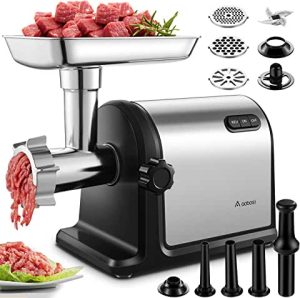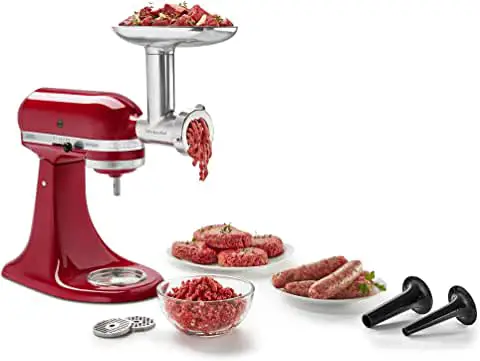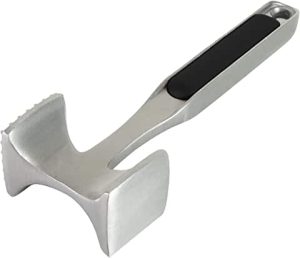Every butcher and chef knows that the efficiency and frequency of meat production are directly tied to the quality of the equipment used to prepare the meat. For this reason, having a top-of-the-line meat grinder machine is essential.
Investing in a new meat grinder for your commercial kitchen is crucial if you want to keep your successful butcher shop going. But there are a few things to think about before you go out and buy it. These are crucial considerations when selecting a meat grinder that can keep up with your production demands.
Tenderized meat has had its muscle fibers broken down to make it more manageable for chewing and digestion. It’s useful when preparing really thick chunks of meat. It also does a great job while preparing or cooking the meat.
No products found.
Tenderizing meat before cooking often necessitates the use of a hand-powered tool known as a meat tenderizer, meat pounder, or meat mallet. Dishes, including chicken-and-fried steak, are “pounded out” using a meat pounder. This will allow them to achieve a uniform thickness and width.
One of the most preferred ways of softening your meat to make it easily chewable is by grinding the meat. Grinding meat results to minced meat which is not only easy to chew, but enables preparation of various meat delicacies such as meat stew to go with your spaghetti and meat balls.
How a meat grinder works
Despite its seeming complexity, a meat grinder is a simple kitchen gadget with only one purpose: grinding meat. You feed the meat into a feed tube. Then it moves along a screw conveyor to a cutting plate, which sets the thickness of the slices. The meat is pushed out of the back of the grinder once it has been ground.
Whether you’re making meatballs, burger patties, or something else, every meat grinder has the right plate attachments for the job. In addition to vegetables and fish, you can use them to chop other foods finely.
No products found.
Why use a meat grinder?
The “meaty” flavors of the meat are preserved more effectively when you grind it yourself. Also, the resulting product is noticeably fresher than anything you could buy from a supermarket. You can adjust the final product’s fat content, whatever you like. Other advantages include the following:
Improving the meat texture
Meat that has been sitting in its packaging on the shelves of a butcher shop or grocery store has likely gone through compression and oxidation. In addition to keeping the meat loose and improving its moisture and texture after it has been cooked, grinding it fresh can help keep it fresh.
Accuracy
You can customize the texture of your ground beef for sausages and patties to your liking. When you do it yourself, use different attachments to mince different kinds of meat, fat, etc.
Home mincing saves money
Most supermarkets charge a premium for their minced meat, so it makes financial sense to buy it in bulk and mince it at home.
Guaranteed hygiene
Home meat grinding lowers E. coli significantly. This is also the safest and surest way to avoid consuming artificially preserved meat. In addition, the highest standards of cleanliness will be applied to the work.
No products found.
The advantages of grinding your own meat at home:
-
Better texture
The meat stays loose and retains more moisture if you mince it just before use, as opposed to purchasing meat that was minced hours before consumption.
-
Improved taste
You decide what kind of meat and how much fat to use in your machine. Since oxygen damages the flavor and nutrients in meat, it’s best to grind it as soon as possible after purchase.
-
Increased safety and health
Reducing the potential for contamination in commercial packaging. When you grind your own meat, you are able to pick lean cuts thus avoiding the risk of eating fatty meat which may increase the risk of increase cholesterol and other health conditions associated with consuming too much fat.
-
Guaranteed freshness
One of the main concerns about purchasing meat that is ground commercially is the risk of using over stayed meat. When you grind your own meat, you are able to choose fresh meat for grinding.
Types of manual meat grinders
No products found.
People who go for the mechanical model still need to think about which model they want before making a purchase.
- Pay attention to the alloy information when shopping for an aluminum meat grinder. Keeping your knives in good shape and using an aluminum-silicon unit will help them last for many years. However, the aluminum-magnesium alloy is easily broken, even without any scrolling at all.
- Cast iron appliances are the sturdiest, but also the heaviest. They’re powerful but have one weakness: they can’t take a tumble without breaking. They also can’t take a violent impact without breaking.
- If the Soviet-era meat grinder was comparable to an aluminum or cast-iron model. The present plastic one bears little resemblance to its forebears. They have a sleek, minimal design and are made of modern, lightweight, high-impact plastic.
- Stainless steel is typically used to produce components for industrial-sized appliances rather than consumer-grade versions. Aluminum alloys and cast iron are common materials for meat grinder construction.

The vacuum mount permits such models to be fastened in place around the perimeter and in the center of the work surface. No more pushing meat with your hands and risking your fingers. The handle simply rotates and a press occurs.
Meat Tenderizers
No products found.
You can cook meat of any kind—chicken, steak, or roast, such that it is luscious and soft. Try using a meat tenderizer to get the results you want from your meat. Tenderizers work by physically separating the meat’s protein fibers. This is to allow water to permeate the meat as it cooks easily.
Which meat tenderizer is best depends on the size and thickness of the meat, the space on the counter, the availability of safety measures to make sure the tenderizer is used correctly, and other things.
Considerations When Purchasing a Meat Tenderizer
Easy to clean
Hand wash aluminum meat tenderizers rather than put them in the dishwasher. Check that you can safely and effectively clean the blades and any other pieces of the tool.
Safety
A grip or handle that doesn’t slip will come in handy in many situations, especially when your hands are wet, oily, or sticky from food. Be cautious when using, cleaning, and storing anything with a sharp edge or blade.
Design
What kind of cooking you intend to do will determine whether you need a tenderizer with more of a flattening, tenderizing, or pounding feature. Check the tool’s balance of comfort, heaviness, and weight and the non-slip quality of the grip. This is to make sure you can easily keep control when using it.
Conclusion on Meat Grinders
Meat grinders can transform tougher portions of meat into something more appetizing later. Putting meat through a grinder results in ground pork, turkey, beef, and lamb.
If you own a meat grinder, you are able to diversify your menu and prepare foods such as meat burgers, meat balls and tasty stews to accompany your carbs.
On the other hand, a meat tenderizer works well on meats that have the potential to be of a higher grade. Tenderizing occurs when tough proteins are softened before cooking. For this reason, there will be far less chewiness when you consume it.


